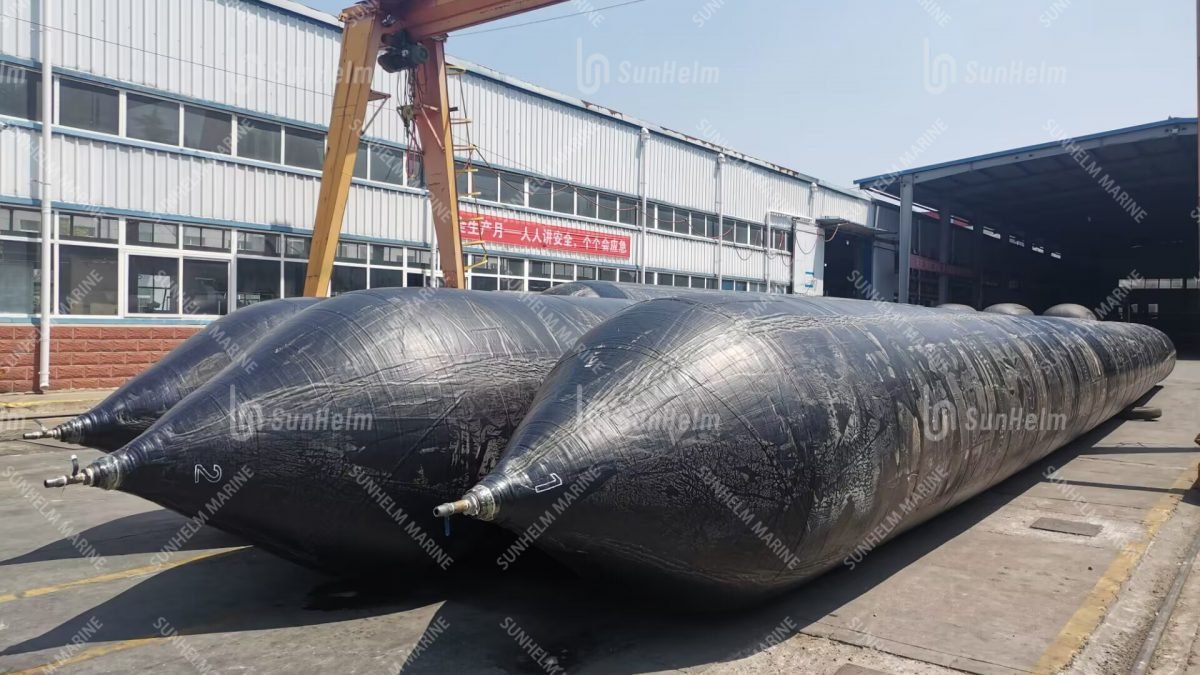Ship launching airbags have revolutionized the way vessels are launched into the water. With their flexibility, efficiency, and cost-effectiveness, they are now widely used in shipyards around the world. However, safe and successful launching relies heavily on a standardized and professional operation process. In this article, we walk you through the complete operation steps while highlighting essential safety and maintenance guidelines.

Why Airbag Operation Needs Strict Control
Unlike traditional ship launching methods, airbag launching involves inflatable rubber structures under high pressure. Improper use or neglect can result in accidents, equipment damage, or personal injury. For this reason, operators must fully understand airbag characteristics, including the rated working pressure and lifting capacity. It is critical not to exceed the maximum pressure limit during any part of the operation.
Step 1: Site and Equipment Preparation
Before inflating any airbags, a thorough inspection of the working site and equipment is essential:
- Inspect the ship’s bottom and ground for sharp objects that could puncture the ship launching airbags. Remove all debris, nails, or rocks that might damage the airbag body.
- Arrange the ship launching airbags according to the ship’s weight, bottom width, and launching direction. Ensure that airbags are spaced evenly and aligned properly.
- Check each airbag for surface damage, valve conditions, and sealing plugs. Only undamaged ship launching airbags should be used.
Step 2: Connecting the Air Source
Proper air supply is a crucial part of safe airbag operation:
- Calibrate pressure gauges before inflation.
- Confirm that air hoses are securely connected to both the pump and the airbag’s valve. Check for any leakage in the air system.
- The air supply should be 6–8 m³/min with pressure below 0.8 MPa.
Step 3: Controlled Inflation Process
Inflation must follow a step-by-step method to avoid damage:
- Open the main air valve and check the air flow and cleanliness. If there’s visible moisture or dirt, release the drain valve on the compressor tank to clean it out.
- Partially open the airbag valve to flush out dust or debris inside the nozzle using internal air pressure.
- Once clean, insert the air hose and begin inflation. Close the valve once the designated pressure is reached, and check for air leaks.
Step 4: Monitoring During Lifting and Movement
As the ship starts to rise and move:
- Regularly monitor internal airbag pressure using a gauge.
- If pressure drops, reinflate promptly to maintain stability and avoid stress imbalance.
- During rolling, ensure that the ship launching airbags do not twist along their length. Twisting can cause material fatigue or rupture.
Step 5: Controlled Deflation After Launching
After the vessel enters the water safely:
- Open the deflation valve slowly, reducing internal pressure to below 0.03 MPa before removing the hose.
- Avoid standing in front of the air outlet. When loosening the air valve, use your thumb and fingers to grip both sides, and keep your body to the side for safety.
- This controlled deflation process prevents the sudden release of pressure, which can be hazardous.
Step 6: Post-Operation Inspection and Reporting
After use:
- Inspect each airbag for surface cracks, deformations, or valve damage.
- Record the condition of each unit. If damage is found, label it and report it to the supervisor for repair or disposal.
- Transport damaged ship launching airbags to the designated area for repair or recycling.
Step 7: Transport and Handling Guidelines
- When transporting a single airbag that has not been deflated, use the plug end as the lifting point—never use the inflation valve for lifting.
- For folded airbags, secure with ropes during hoisting to prevent accidental drops.
Step 8: Long-Term Storage and Maintenance
Proper storage ensures a long airbag service life:
- Clean the airbags thoroughly, allow them to dry, and apply talcum powder both inside and outside the surface.
- Store them indoors in a cool, dry, and well-ventilated space, away from heat sources.
- Avoid contact with acids, alkalis, oils, or organic solvents.
- When not in use, lay the airbags flat; never stack or place heavy objects on top of them.
Conclusion
The ship launching airbag process may appear straightforward, but it demands technical knowledge, precision, and strict adherence to safety protocols. By following these detailed steps—from preparation to storage—you not only ensure a successful launching operation but also extend the lifespan of your equipment.
At Sunhelm, we provide reliable marine airbags built to meet international standards, and our technical team is always ready to support your next ship launching project.


